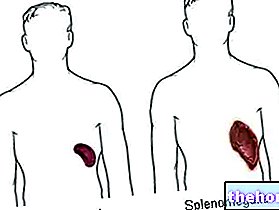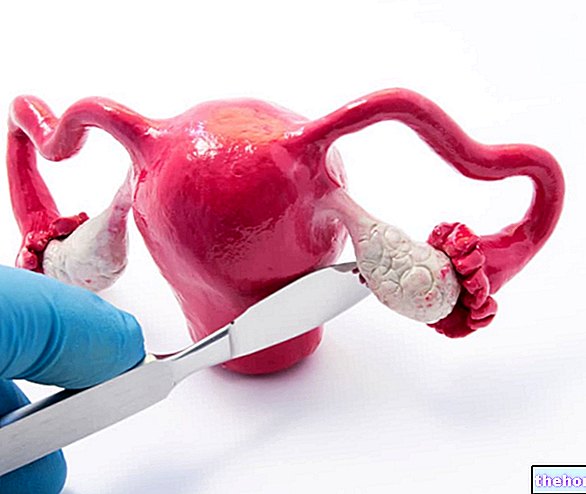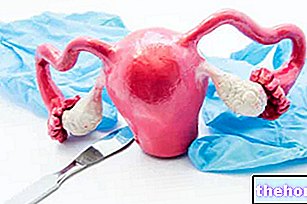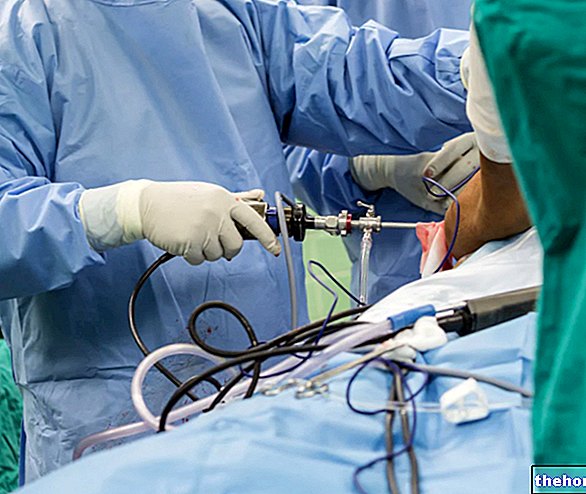Generality
Splenectomy is the surgical removal of the spleen, which is performed when the organ is irreparably damaged or no longer functions properly.
The spleen performs important functions, such as fighting infections and promoting the maturation of red blood cells, but it is not a vital organ.

Figure: front view of the human body. The spleen, in red, is located in the upper left part of the abdomen, next to the stomach and pancreas, below the diaphragm and above the intestine.. From the site: buzzle.com
Therefore, its removal does not reduce the patient's life expectancy.
Splenectomy can be performed in two different ways: with a laparoscopic technique or with a traditional (or open) procedure. Generally, it is rare for the surgery to involve complications, however, in order to be successful, it is good to follow the advice of the doctor.
Full recovery from the operation takes 4 to 6 weeks.
What is splenectomy?
Splenectomy is the surgery to remove the spleen, performed when the spleen has suffered irreparable damage or is no longer functional due to a serious illness.
The spleen is a fist-sized organ of the abdomen located just below the rib cage on the left.
The spleen has several functions:
- It fights infections by controlling the presence of circulating pathogens (bacteria and foreign particles) and producing antibodies and white blood cells.
- Promotes the maturation of red blood cells (erythrocytes).
- It clears the blood of aging (a red blood cell has an average life of 120 days) or damaged red blood cells.
- It acts as a reserve of iron, platelets and white blood cells.
When you do
Splenectomy surgery is performed when one of the following conditions or pathologies appears:
- Rupture of the spleen. Caused by an abdominal trauma, it causes internal bleeding, which, if not stopped, can lead to death. Splenectomy is, very often, the only viable solution to stop blood loss.
Splenomegaly, a pathological condition in which the spleen is enlarged, is one of the factors favoring the rupture of the spleen, as the latter is more exposed to shocks due to its considerable size. - Diseases of the blood. Some serious blood disorders, such as sickle cell anemia, thalassemia, polycythemia vera, or idiopathic thrombocytopenic purpura, may require splenectomy. The decision to remove the spleen, however, is only made after all other possible treatments are not successful.
- Tumors. Certain cancers, such as chronic lymphocytic leukemia, Hodgkin's lymphoma, non-Hodgkin's lymphoma, or hairy cell leukemia, can also affect the spleen, causing it to enlarge (splenomegaly). As in the previous case, if all the treatments implemented for the treatment of splenomegaly are ineffective, it is necessary to resort to splenectomy.
- Infections. Some pathogens (viruses, bacteria and parasites) can inflame the spleen, causing splenomegaly. If the infections are very serious and the treatments are ineffective, the last remedy is the "removal of" the inflamed organ. Some examples of pathogens causing splenomegaly (and potentially requiring splenectomy) are malaria plasmodium (a parasite) and syphilis bacterium.
- Cysts or benign tumors. The spleen can develop cysts or benign tumors, which alter its normal anatomy. If these malformations are large or if their complete surgical removal is impossible, splenectomy is the only viable remedy.
- Special cases. On very rare occasions, the spleen can enlarge without a precise cause, or rather without a cause that can be documented through diagnostic tests. In these cases, setting up a therapy is difficult, because you don't know what the trigger is.

Therefore, the only remedy, to avoid the complications of splenomegaly, is represented by splenectomy.
Risks
Thanks to medical advances, splenectomy is now a "safe operation. However, its execution, like that of any other surgery, presents potential risks, which should not be underestimated.
Hemorrhages, blood clots (thrombi), wound infections and injuries to adjacent organs (stomach, pancreas and colon) are the four most important complications of spleen removal.
LIVING WITHOUT SPLEEN: LONG-TERM RISKS
The spleen, as mentioned, fights infections by producing antibodies and white blood cells; therefore, it has a role within the so-called immune system, that is the defensive barrier that protects the human organism from pathogens and foreign bodies.
The lack of a spleen, in itself, does not affect a person's life expectancy, yet it exposes them to all types of infections, from the mildest to the most serious. This situation is also known as post-splenectomy immunosuppression.
In light of this, it is recommended to get vaccinated against the pneumococcal bacterium, which causes pneumonia, and, year after year, against the flu.
Furthermore, another preventive measure, adopted in particular pathological conditions, is to take antibiotics, which raise a wall against the bacterial agents present in the environment.
Preparation
Splenectomy, if planned for some time (ie if it is not an emergency operation), includes the following preoperative measures:
- Blood transfusion. This serves to reduce the impact that the removal of an organ such as the spleen has on the patient. It is practiced just before the intervention.
- Pneumococcal vaccine. It is used to prevent pneumonia, which, in individuals deprived of the spleen and not vaccinated, occurs very frequently.
- Present yourself on an absolute fast. Splenectomy is performed under general anesthesia, therefore it is required not to eat and not to take liquids for several hours before the operation.
- Stop taking certain drugs. In view of the intervention, there are drugs that should not be taken at all (for example, anticoagulants). For this reason, it is important for the patient to tell their doctor about all the medicines they are taking or have taken in the recent past.
Procedure
After general anesthesia, with which the patient sits down, splenectomy can be performed with two different surgical procedures: through laparoscopy or through a traditional open technique.
At the end of the operation, however it was carried out, a hospitalization of at least a couple of days and complete rest for at least a week is required.
GENERAL ANESTHESIA
General anesthesia involves the use of anesthetics and pain relievers, which make the patient unconscious and insensitive to pain.
The administration of these drugs, carried out intravenously and / or by inhalation, takes place before and for the entire duration of the surgery.
After the operation, in fact, the pharmacological treatment is stopped, to allow the patient to regain consciousness.
LAPAROSCOPIC OR MINIMALLY INVASIVE SPLENECTOMY
Laparoscopic splenectomy is performed in the following way.
The surgeon, first of all, makes four small incisions on the patient's abdomen; through one of these, he inserts a tiny video camera, which, connected to a monitor, allows him to orient himself during the subsequent maneuvers. Then, through the other three incisions. , leads the instruments for the "isolation and" extraction of the spleen.
The whole procedure takes place with the patient positioned on the right lateral side (right lateral decubitus), in such a way that the spleen "lends itself" better to "removal.

Figure: the incision points, for laparoscopic splenectomy. You can see the hole, from which the spleen is extracted, and the position made to the patient (right lateral decubitus). From the site: www.acssurgery.com
- Benefits: The procedure is minimally invasive. In fact, with only four small incisions, it is possible to extract an internal organ.
- Disadvantages: Laparoscopic splenectomy is not suitable for everyone. In fact, people with very large spleens usually require open surgery.

Figure: During laparoscopic splenectomy, the spleen is first separated from the supporting ligaments and blood vessels that supply it. These operations are performed in such a way as to minimize bleeding. Subsequently, the organ to be extracted is inserted into a sort of bag and dragged outside. There is also the possibility of crushing it, once in the bag, and removing it piece by piece. From the site: www.laparoscopy.am
TRADITIONAL OR OPEN SKY SPLENECTOMY
Traditional or open splenectomy is the classic surgery to remove the spleen. It is performed after having incised and opened the upper left part of the abdomen. Once isolated from the vessels and its ligaments, the spleen is carefully extracted, taking care not to damage the other adhering organs.
After the extraction, the abdomen is closed with sutures.
- Benefits: With traditional splenectomy, any size spleen can be extracted.
- Disadvantages: It is an invasive procedure, which requires longer recovery times, compared to laparoscopic splenectomy.
DURATION OF THE INTERVENTION
A splenectomy, regardless of the procedure performed, can last from a minimum of three quarters of an hour to a maximum of 2 hours. The length depends on the size of the spleen and on the internal anatomy of the abdomen, which, in its details, is different from patient to patient.
FREQUENTLY ASKED QUESTIONS ON THE "INTERVENTION
How long is the incision on the abdomen in open surgery?
It can vary from 12 to 20 centimeters.
Once the spleen is removed, is there any other organ that performs the same functions as it?
Yes, the functions of the spleen are partially covered by the bone marrow and the so-called reticulo-endothelial cells.
Is it possible to have children, even without a spleen?
Yes, provided that the removal of the spleen was not due to leukemia or malignant tumors; in such conditions, in fact, it is strongly not recommended to have a pregnancy.
Post-operative phase
After the surgery, a hospital stay is foreseen, which can range from a minimum of two days to a maximum of six. The length of stay is at the discretion of the treating physician, who decides on the basis of the state of health of the operated patient. .
After discharge, it is necessary to be at complete rest for at least a week. During this period, it is imperative to follow the doctor's advice to the letter, who will prohibit even the simplest and most common daily activities, such as bathing, driving, etc.
Full recovery usually occurs within 4-6 weeks.
BACK TO EVERYDAY ACTIVITIES
The resumption of normal daily activities (working, driving the car, doing housework, etc.) must begin shortly after the rest period, not before, and must be gradual. Generally, you have to wait 10-14 days from when you have undergone the intervention; however it is advisable that each stage is always agreed, in advance, with one's own doctor. In fact, each patient is a separate case.
The time required for the return to sporting activity ranges from 8 to 10 weeks, depending on the sport that is usually practiced (contact sports clearly require longer times).
Activities
Waiting times from the day of the intervention
Bathe
10-14 days (depends on the type of splenectomy procedure)
To drive
10-14 days
Doing the housework
12-14 days, for light tasks; a few more days for heavy tasks
Work
12-14 days, for lighter jobs; not less than 4 weeks for the heaviest jobs
Playing sports
8 weeks, if the sport practiced is not contact; 10 weeks, if the sport practiced is contact (football, rugby, etc.)
PERIODIC CHECKS
After the operation, it is important to undergo periodic blood tests to assess how recovery is progressing and to prevent any complications.
Results
The success of splenectomy depends mainly on the underlying disorder that required its implementation. In other words, to give a practical example of what has just been said, a subject with severe leukemia will obtain partial benefits from the intervention, as the removal of the spleen only serves to alleviate the symptoms; vice versa, an individual with a severe trauma to the spleen, once having a splenectomy, will be able to recover completely and resolve any ailments.
LIVE WITHOUT SPLEEN
Living without a spleen is possible, as long as you follow all the appropriate medical advice, namely:
- Get vaccinated against the pneumococcal bacterium and, annually, against the influenza virus
- Get regular blood checks
- Contact your doctor at the first signs of infection
For those who have undergone a splenectomy, there is the possibility of wearing identification bracelets.





























